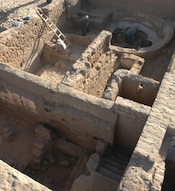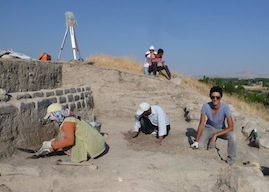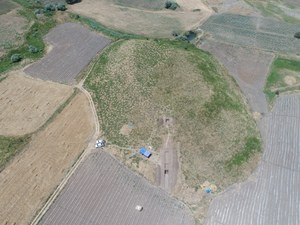Archaeological Projects
As a route to understanding the diverse civilizations of the ancient world and their interactions with one other through the study of material traces that have been left behind, the Institute for the Study of the Ancient World sponsors a robust program of archaeological fieldwork activity focusing on periods ranging from the 5th millennium BCE to the early medieval period. This program includes faculty-led projects in Egypt, Turkey, Iraqi Kurdistan, Uzbekistan, and China. ISAW faculty also contribute to fieldwork projects throughout the Mediterranean world and Asia Minor at sites such as Crete, Troy, and Kenchreai. In addition, ISAW visiting scholars currently lead or participate in fieldwork projects in Tunisia, Iraq, Mongolia, and China. ISAW offers training for students in archaeological theory, practice, and science; provides funding for students to participate in ISAW-sponsored and other fieldwork activity; and in some cases helps to facilitate students starting their own fieldwork projects.
The Oasis Wall Around Bukhara, Uzbekistan
Prof. Sören Stark
Territorial barrier-walls are a widespread phenomenon in many micro-regions of Western Central Asia where they often take the shape of large-scale oasis walls. One of the best-preserved examples of such a ‘long wall’, associated with a multitude of fortresses, forts and watch-towers, can be found around the oasis of Bukhara, one of Central Asia’s major urban centers. This project investigates these features by combining archaeological survey work with stationary excavations, and is carried out in cooperation with the Institute of Archaeology at the Academy of Sciences of Uzbekistan in Samarkand. See here for more information about our on-going research in the Bukhara region.
Amheida, Egypt
Dr. David M. Ratzan

NYU's excavations at the ancient city of Amheida (known as Trimithis in the Roman period) are a modern, multidisciplinary excavation by an international team of a large urban site with remains from the Old Kingdom to the late Roman period. Finds include the only known ancient school, mythological wall paintings, early churches. and the only standing mud-brick pyramid of the Roman period. As of 2022, we have published six substantial monographs on our work via ISAW Monographs, with several more currently in production. For more information, field reports, plans, images, database access, and bibliography, please visit: https://isaw.nyu.edu/research/amheida
Kınık Höyük, Nigde, Turkey
Prof. Lorenzo d’Alfonso
 A joint Italian-American team is excavating at Kınık Höyük, a pre-classical, intact site in southern Cappadocia, Turkey. This wealthy region once controlled the main passage through the Taurus mountains of the route connecting Europe and Asia. Finds and 14C dates indicate that the main occupation periods at the site starts at about 3000 BCE, and cover the Bronze Age, the post-Hittite, the Achaemenid, and Hellenistic periods, while a seasonal occupation of the summit of the site occurred in the Seljuk to Early Ottoman period.. The state of preservation of the Hellenistic and the Iron Age architecture excavated on the mound is unique in the region, so that restoration in addition to excavation is a main activity at Kınık, with the goal of opening an open-air museum. www.kinikhoyuk.org
A joint Italian-American team is excavating at Kınık Höyük, a pre-classical, intact site in southern Cappadocia, Turkey. This wealthy region once controlled the main passage through the Taurus mountains of the route connecting Europe and Asia. Finds and 14C dates indicate that the main occupation periods at the site starts at about 3000 BCE, and cover the Bronze Age, the post-Hittite, the Achaemenid, and Hellenistic periods, while a seasonal occupation of the summit of the site occurred in the Seljuk to Early Ottoman period.. The state of preservation of the Hellenistic and the Iron Age architecture excavated on the mound is unique in the region, so that restoration in addition to excavation is a main activity at Kınık, with the goal of opening an open-air museum. www.kinikhoyuk.org
The Chinese Bronze Age Economics Project
Prof. Roderick Campbell
 My fieldwork consists of a series of assemblage analyses at a number of Anyang period (ca. 1250-1050 BCE) sites. These include the massive Shang capital site at Anyang (3000 ha), the regional center of Daxingzhuang (30 ha), and the village of Guandimiao (2 ha), selected as different types of node in the Shang kingdom's political economic networks. I have five ongoing research projects at these sites, four of which involve bone working. The first project is a collaboration with the Chinese Academy of Social Sciences, Institute of Archaeology on the huge bone workshop at Tiesanlu Anyang, where 34 metric tons of animal bone waste was recovered and preliminary studies have shown that millions of hairpins for broad consumption were mass-produced. Work began in 2009 and continues with the current focus on production organization. At Zhengzhou, I have been working on the only excavated Shang village site, Guandimiao. This collaboration is with the Henan Provincial Institute of Cultural Relics and Archaeology. So far a preliminary English site report has been written as well as bone working and zooarchaeological reports completed. The worked bone analysis demonstrated surprising connections with the large-scale workshops of the capital, even while differentiating a distinct local, non-specialized production. Further work will focus on Guandimiao ceramic production and the bone working remains from the Erligang period (ca. 1600-1400 BCE) Zhengzhou bone workshop. At Jinan research into the Daxingzhuang worked bone assemblage is ongoing with Shandong University. Preliminary work suggests both local, small-scale, specialized production, and connections with the Anyang workshops. In addition to the Daxingzhuang bone artifact analysis my collaborators and I held a bone working experimental workshop at the Qingdao campus to help us better characterize tool marks and efficiencies. Further experimental workshops are planned.
My fieldwork consists of a series of assemblage analyses at a number of Anyang period (ca. 1250-1050 BCE) sites. These include the massive Shang capital site at Anyang (3000 ha), the regional center of Daxingzhuang (30 ha), and the village of Guandimiao (2 ha), selected as different types of node in the Shang kingdom's political economic networks. I have five ongoing research projects at these sites, four of which involve bone working. The first project is a collaboration with the Chinese Academy of Social Sciences, Institute of Archaeology on the huge bone workshop at Tiesanlu Anyang, where 34 metric tons of animal bone waste was recovered and preliminary studies have shown that millions of hairpins for broad consumption were mass-produced. Work began in 2009 and continues with the current focus on production organization. At Zhengzhou, I have been working on the only excavated Shang village site, Guandimiao. This collaboration is with the Henan Provincial Institute of Cultural Relics and Archaeology. So far a preliminary English site report has been written as well as bone working and zooarchaeological reports completed. The worked bone analysis demonstrated surprising connections with the large-scale workshops of the capital, even while differentiating a distinct local, non-specialized production. Further work will focus on Guandimiao ceramic production and the bone working remains from the Erligang period (ca. 1600-1400 BCE) Zhengzhou bone workshop. At Jinan research into the Daxingzhuang worked bone assemblage is ongoing with Shandong University. Preliminary work suggests both local, small-scale, specialized production, and connections with the Anyang workshops. In addition to the Daxingzhuang bone artifact analysis my collaborators and I held a bone working experimental workshop at the Qingdao campus to help us better characterize tool marks and efficiencies. Further experimental workshops are planned.
Gird-i Rostam, Iraqi Kurdistan
Prof. Daniel T. Potts
 Gird-i Rostam is a multi-period site in Iraqi Kurdistan occupied from the Chalcolithic period (c. 4400 BC) to late Antiquity (5th-7th cents. AD). After a brief mapping campaign in 2017 excavations began in 2018 as a joint project between ISAW and the Ludwig-Maximilians-University in Munich with the enthusiastic support of the Directorate of Antiquities in the Governate of Suleimaniyah and its Director Kamal Rasheed. Co-directed by Dan Potts and Karen Radner (Munich), the project aims to establish a sequence for this little-known, easternmost corner of Kurdistan which lies close to the Iranian border in the Zagros mountains. Die-stamped ceramics with Christian crosses; prehistoric obsidian from sources near Nemrut Dag in Turkey and Syunik in Armenia; painted pottery parallels in Luristan and northern Mesopotamia; and a vessel fragment with a cuneiform inscription naming the dedicant, in all probability of Neo-Assyrian date, already suggest that Gird-i Rostam is going to contribute enormously to our understanding of the prehistory and early history of the Zagros. A full preliminary report on the 2018 season is currently in press and will appear in the Dutch journal JEOL (Jaarbericht Ex Oriente Lux) in 2019 when another season of excavations is planned.
Gird-i Rostam is a multi-period site in Iraqi Kurdistan occupied from the Chalcolithic period (c. 4400 BC) to late Antiquity (5th-7th cents. AD). After a brief mapping campaign in 2017 excavations began in 2018 as a joint project between ISAW and the Ludwig-Maximilians-University in Munich with the enthusiastic support of the Directorate of Antiquities in the Governate of Suleimaniyah and its Director Kamal Rasheed. Co-directed by Dan Potts and Karen Radner (Munich), the project aims to establish a sequence for this little-known, easternmost corner of Kurdistan which lies close to the Iranian border in the Zagros mountains. Die-stamped ceramics with Christian crosses; prehistoric obsidian from sources near Nemrut Dag in Turkey and Syunik in Armenia; painted pottery parallels in Luristan and northern Mesopotamia; and a vessel fragment with a cuneiform inscription naming the dedicant, in all probability of Neo-Assyrian date, already suggest that Gird-i Rostam is going to contribute enormously to our understanding of the prehistory and early history of the Zagros. A full preliminary report on the 2018 season is currently in press and will appear in the Dutch journal JEOL (Jaarbericht Ex Oriente Lux) in 2019 when another season of excavations is planned.
For archaeological resources within the wider NYU network see the NYU Archaeohub.